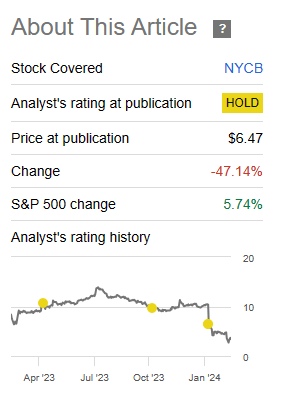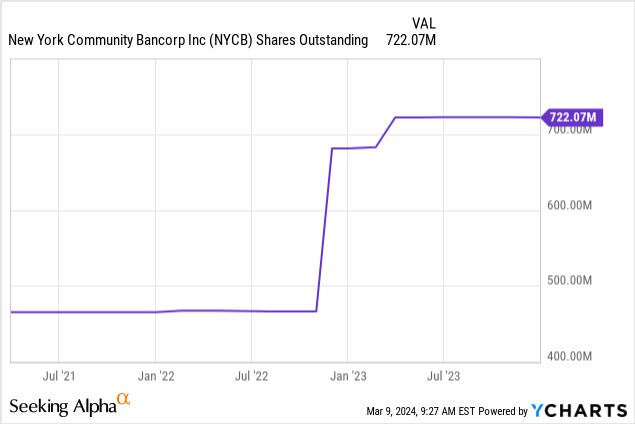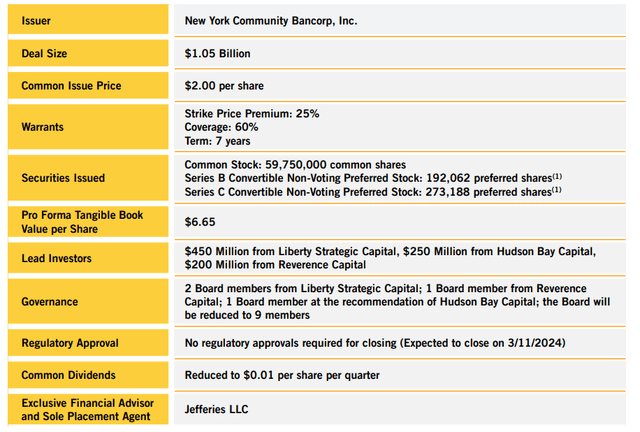Spencer Platt
There are sometimes no prizes for heroics. Sometimes a stock is sold for a good reason and as much as price anchoring makes us think it is “cheaper” than the day before, one must always look at the facts first. Looking at what was an avalanche of bad news from New York Community Bancorp, Inc. (NYSE:NYCB), we decided that discretion was the better part of valor, and we were not buying the 37% one-day drop.
But the story has changed. Big money managers won’t be chasing this after being blindsided with this quarter’s results. How do they go from almost 180% dividend coverage to a 70% dividend reduction in four quarters? We know the bulls will be lining up to punch us, but whatever story you believed in before these results, it was wrong. Wrong, wrong, wrong. This is a new day, and it will take at least six quarters to rebuild confidence. And guess what? You are no longer getting paid to wait. We don’t have a position here, and we likely won’t initiate one.
Source: Tanks A Lot For The Dividend Cut
The stock has stimulated demand for antacids at a furious pace since then and delivered another 53% underperformance.
Seeking Alpha
We go over the material developments since then and weigh in prospects for the beleaguered bank.
1) Material Weakness
NYCB did the double slam on its shareholders in late February. Investors were still reeling from the dividend cut and got a goodwill impairment and disclosure of material weakness in controls.
The Company completed its goodwill impairment assessment on February 23, 2024 and management determined that Generally Accepted Accounting Principles required a “goodwill impairment” charge on the Company’s “Consolidated Statements of Income and Comprehensive Income” for the quarter and fiscal year ended December 31, 2023, resulting in a $2.4 billion decrease to the fourth quarter and annual net (loss) income available to common stockholders.
Separately, as part of management’s assessment of the Company’s internal controls, management identified material weaknesses in the Company’s internal controls related to internal loan review, resulting from ineffective oversight, risk assessment and monitoring activities. Although assessment of the Company’s internal controls is not yet complete, the Company expects to disclose in the 2023 Form 10-K that its disclosure controls and procedures and internal control over financial reporting were not effective as of December 31, 2023.
Source: NYCB 8-K
These weaknesses appeared to be across the board in a number of areas that significantly change the picture for the bank. If loan reviews and risks assessments were failing, how were we to believe that the loan to value ratios are accurate? How are we to have faith in the provisions? It is certainly possible that these weaknesses resulted in a few real changes to the actual bottom line. It is also possible that there are some big weaknesses in the loan origination for at least the 2023 vintage. Investors hoping for a rather quick resolution are likely to be disappointed. These fixes take time as the whole process has to be reviewed and estimates need to be made on loan quality and potential losses. There is some auditor discretion as to how this proceeds, but with a large regional bank in the spotlight, you can expect the treatment to be rough. At a minimum, we are expecting yet another charge from higher provisions. Worst case, this could get dragged on for weeks increasing uncertainty.
2) Capital Raise
NYCB shares had waves of buying and selling, but generally headed lower since our last article. The drama reached its climax as the bank which boasted great liquidity one month back was apparently seeking a capital raise. The stock dropped 45% intra-day with at least 4 different halts. The New York Community Bancorp, Inc. DEP SHS REPSTG A (NYSE:NYCB.PR.A) and New York Community Capital Trust V UNIT 05/07/51 (NYCB.PR.U) went through similar drops. Tragically enough, these were all halted at different times throughout the day as the stock exchanges struggled to control the panic. The capital raise story was semi-accurate, as NYCB had actually completed the raise for $1.0 billion by mid-day.
Under terms of the deal, NYCB will sell to the investors shares of common stock at a price of $2.00 per share and a series of convertible preferred stock with a conversion price of $2.00, for an aggregate investment of $1.05B. The investors will also get 60% warrant coverage to purchase non-voting, common-equivalent stock with an exercise price of $2.50 per share, a 25% premium to the price paid on the common stock.
Source: Seeking Alpha
This is pretty huge in terms of how much equity buffer it adds but it also destroys the upside as we shall see in the valuation section.

3) Valuation
You remember the good old days when NYCB was cheap with a forward P/E of 6.5X, even though it traded at $9.00? Back then there was a high degree of consensus of what those earnings would look like. Fast forward to the middle (we are nowhere near the end) of this drama, and this is what the estimates look like. Earning estimates are down from the peak of about $1.40 to $0.20 and the range is crazy with many projecting losses.
Seeking Alpha
We think the analyst predicting the $0.83 is probably on vacation somewhere with no internet service. On no planet will NYCB come in the ballpark of that number with this level of dilution. Total shares outstanding even without the warrants (315 million shares worth) will be close to 1.25 billion, up from the 722 million you see in the Y-charts picture above. NYCB plans to use stock settlement to settle the warrants, assuming they are in the money. This will essentially issue stock only for the upside portion over $2.50. So rather than investors having the right to buy stock at $2.50, they will get the value in shares, equivalent to their upside.
If the stock is at $3.50 at the time of exercise, the bank would give the investor group $315 million worth of stock based on the intrinsic value of the warrants of $1 each ($3.50 less the warrant exercise price of $2.50). That would translate into issuance of about 90 million shares.
Source: NYCB via Barron’s
Tangible book value per share will be around $6.65 after the capital raise is completed (March 11, 2024).
NYCB
We think the warrant dilution alongside further provisions should see an ultimate expected tangible book value of about $6.00 per share. With the stock trading at a 40% discount, you have some buffer here.
Verdict
Earnings are going to be poor for 2024. Pressures will come from more losses and likely significantly higher interest costs as NYCB will try and attract more FDIC insured deposits (i.e. from small customers). We would not be surprised at a big loss for the year. Moving to 2025, earnings will depend on whether we actually see the long-awaited recession or not. But even in the absence of that, the heavily inverted yield curve likely means that generating even 6-7% (35-40 cents a share) on tangible book value will be challenging. You can bet on the curve inversion going away, but that likely means a recession. Even in the best of recent times, NYCB traded at 6-7X earnings. Here, even stretching out to 2025, we see that NYCB is trading at 8X optimistic numbers for 2025. While investors grapple with the fallout and the stock trades on technical levels, we believe that material upside from here is unlikely. The stock is fairly valued at $3.50 despite the big drop from 2 months ago, and we would sell any rallies over $4.50. Investors can use the high implied volatility on options to hedge their position as well. Existential risks have been reduced substantially, but we would not assume that this is a “buy and forget” position. At this point, we think that NYCB.PR.U might be a better bet than the common shares thanks to the very huge yield (9.6%) and the marked reduction of existential risks. NYCB.PR.A on the other hand, yields slightly less (9.1%), is lower in the capital structure, and floats in March 2027. Hence, our preference for NYCB.PR.U.
Please note that this is not financial advice. It may seem like it, sound like it, but surprisingly, it is not. Investors are expected to do their own due diligence and consult with a professional who knows their objectives and constraints.

















